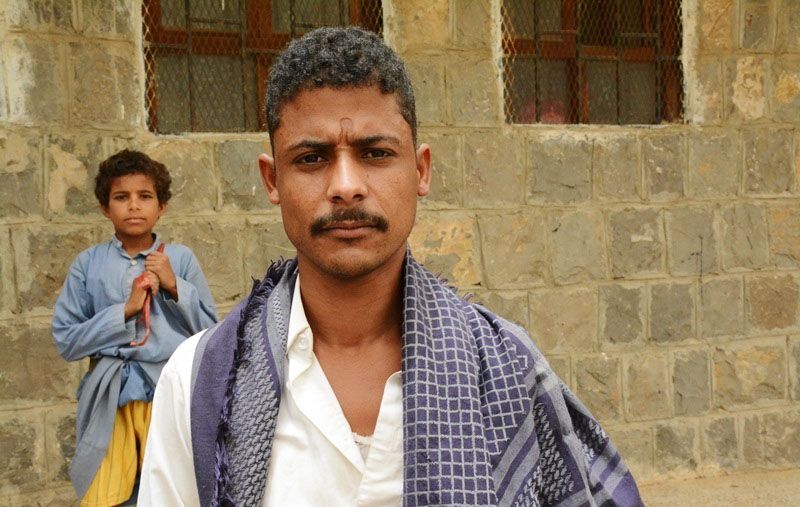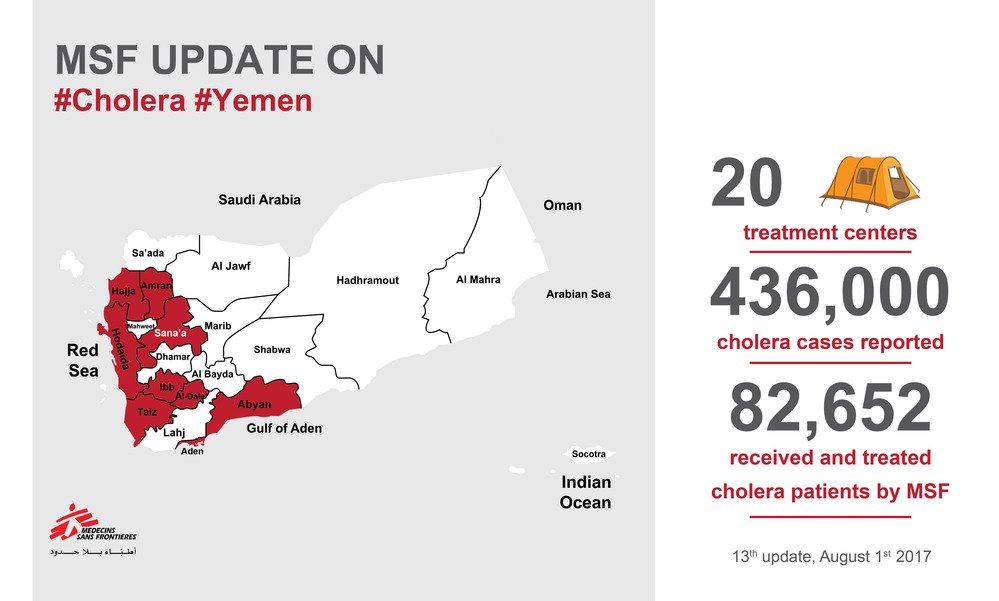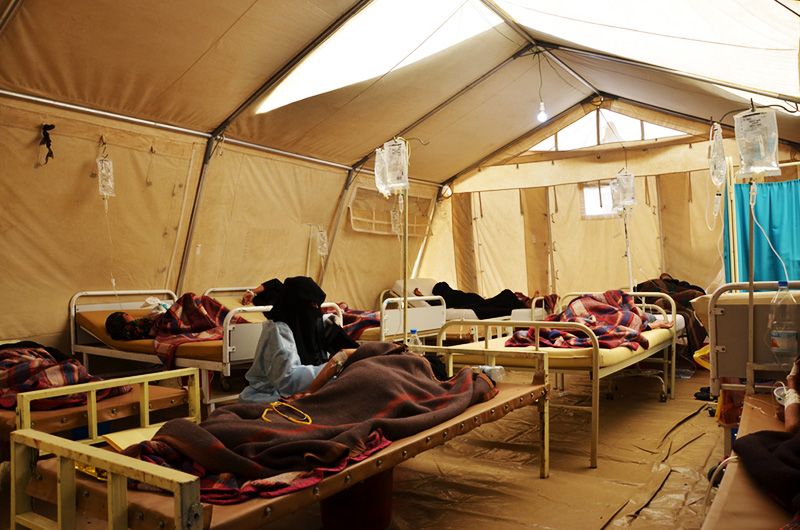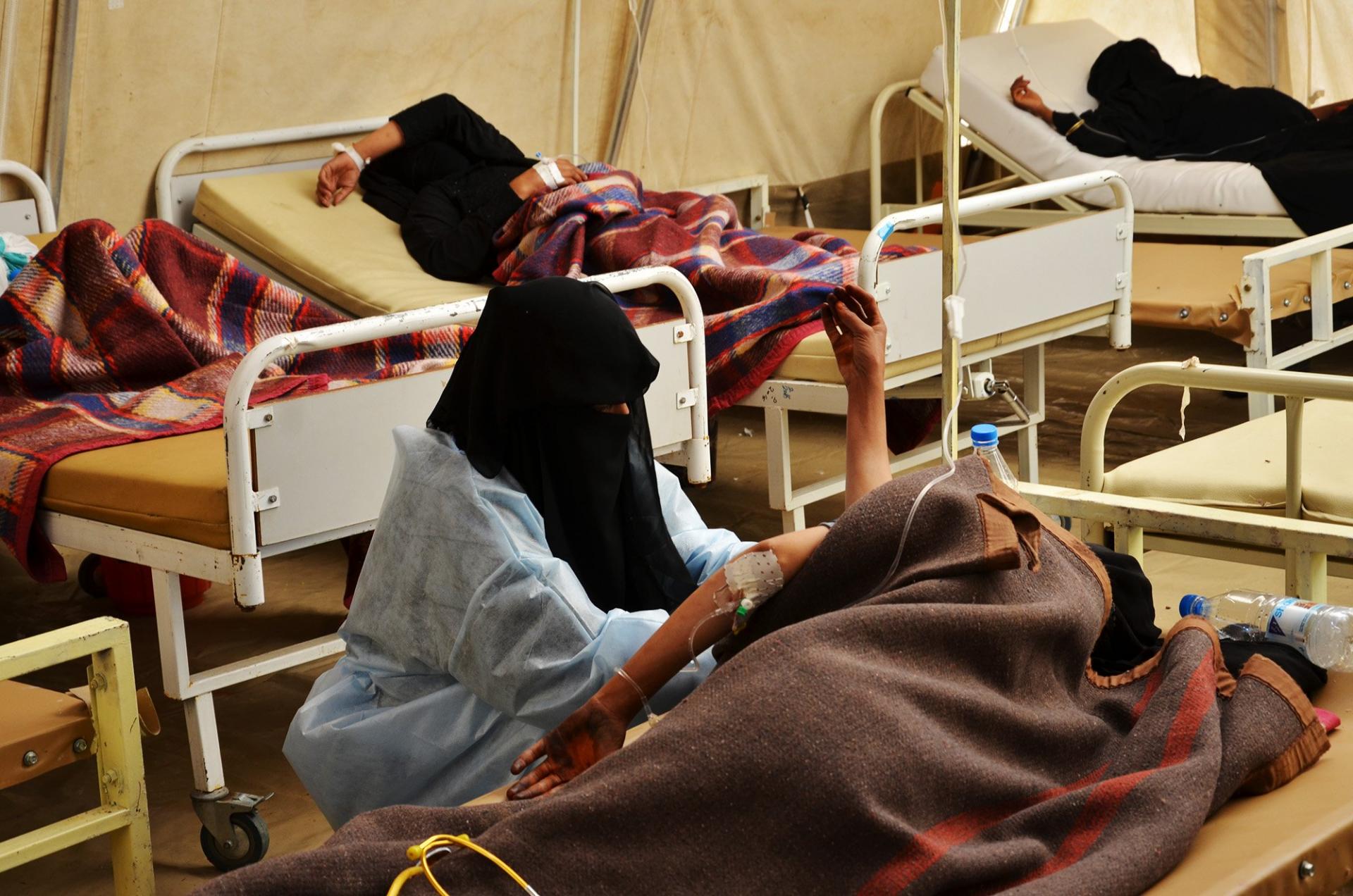Update: 3 August 2017
Four months into Yemen’s cholera outbreak, the number of new cases countrywide may have slowed over the past 10 days, but many people in remote areas are still dying needlessly, warns international medical organisation Doctors Without Borders (MSF).
Unless aid is increased urgently and a preventive approach taken at the community level, people will continue to die of this preventable disease, says MSF.
More than 430,000 people have been affected by the disease since the outbreak was declared on 27th April 2017.
“Some weeks ago, one of my neighbours suffered from severe diarrhoea and vomiting,” says Zayed Al Goidi, from Beit Al Ghwadi, a village in Osman valley, one of the most remote areas of Amran governorate.
“He died the same day, but no one knew the reason. We don’t have televisions or phones, and few of us have a radio, so it took a long time before we understood it was cholera.”
Being able to identify the disease is not enough to save the villagers, most of whom cannot afford to travel for medical care.
“The nearest health facility is several hours from the village and the journey costs up to US$60,” says Al Goidi. “We’re poor and we have almost no means of making a living, so how can we pay so much money? To save our lives, we have to pledge our property: our land, our wives’ jewellery.”

“Our epidemiological data shows that the Osman valley is one of the areas most affected by cholera,” says Ghassan Abou Chaar, MSF head of mission in Yemen.
“Its remote location, people’s poor living conditions and their lack of knowledge about cholera have all contributed to the spread of the disease and the number of deaths caused by it. We can’t simply wait and treat only those patients who manage to reach our cholera treatment centres.
If we don’t reach locations such as the Osman valley, people will keep dying.” Dr Mohamed Musoke, MSF’s emergency coordinator for cholera, travelled to Beit Al Ghwadi from MSF’s hospital in Khamir, 2.5 hours’ drive away.
“The road is very difficult and this place is almost completely cut off,” says Dr Musoke.
“On our way here we crossed the river, the main water source for the community. We saw animals drinking from it, people washing their clothes in it and mothers giving their children water from it to drink.”
In mid-July, MSF teams distributed hygiene items to hundreds of households in the Osman valley and organised awareness sessions on cholera. Since the beginning of the outbreak, MSF has provided treatment for cholera to more than 82,000 patients – one-fifth of all cases identified in the country.
To bring the outbreak under control, MSF calls for other organisations to make a coordinated response that includes water and sanitation activities and health education.
“Wells and water points need to be treated, and people need to be educated in how they can protect themselves from cholera, especially with the upcoming rainy season,” says Abou Chaar.

Update: 17 June 2017
By June 17thth, the number of suspected cholera cases reported by World Health Organization (WHO) & health authorities in Yemen has reached 151,400, (1,054 deaths). The number of cases is way higher compared to the previous outbreak wave (23,506 suspected cases in total between October 2016 and March 21 2017 - WHO). Cases are now reported from 19 governorates out of 22 governorates (the previous outbreak had reached a maximum of 15 governorates).
The poor level of sanitation and lack of safe drinking water is increasing vulnerability of the population due to the ongoing conflict which means they are more susceptible to cholera (particularly if suffering from chronic and acute malnutrition), and the population are having more and more difficulty in accessing health facilities on time (the outbreak is spreading to the more remote and poor communities so they have further to travel and less money for transport).
MSF's response
By June 18th, MSF has received 41,479 patients of cholera and acute watery diarrhea since the start of the rapid increase of the epidemic in early April 2017 (see the figures below). Of the 41,000 patients we received since March 30th, more than 17,000 patients were seen in the past two weeks (since June 4th).
In the first few weeks of the outbreak, MSF was working in 5 cholera treatment centers that it has established with the help of its logistic team. As the number of patients is still on the rise, more cholera treatment centers were established. Today, MSF has 9 Cholera Treatment Centers (CTC), 7 Cholera Treatment Units (CTU) and 2 stabilization units in 9 governorates (Amran, Hajja, Al-Dhale, Hodaidah, Ibb, Taiz, Sana’a, Aden and Abyan. MSF continues to expand the capacity of some of its CTC, opening new ones, supporting other locations through donations and evaluating the needs.
Update: 8 June 2017
By June 8th, the number of suspected cholera cases reported by World Health Organization (WHO) & health authorities in Yemen has reached 101,800, (789 deaths). The number of cases is way higher compared to the previous outbreak wave (23,506 suspected cases in total between October 2016 and March 21, 2017 - WHO). Cases are now reported from 19 governorates out of 22 governorates (the previous outbreak had reached a maximum of 15 governorates).]
MSF's response
MSF has received 24,135 patients of cholera and acute watery diarrhoea since the start of the rapid increase of the epidemic. MSF established 9 Cholera Treatment Centres (CTC), 6 Cholera Treatment Unit (CTU) and 2 stabilisation units in 9 governorates (Amran, Hajja, Al-Dhale, Hodaidah, Ibb, Taiz, Sana’a, Aden and Abyan.
By May 29th, the number of cholera cases reported by World Health Organization had reached more than 50,000. The number of cases is way higher compared to the previous outbreak wave (23 506 suspected cases in total between October 2016 and March 21, 2017 - WHO). Cases are now reported from 19 governorates out of 22 governorates (the previous outbreak had reached a maximum of 15 governorates).
The poor level of sanitation and lack of safe drinking water, increasing vulnerability of the population due to the ongoing conflict which means they are more susceptible to cholera (particularly if suffering from chronic and acute malnutrition), and the population having more and more difficulty in accessing health facilities on time (the outbreak is spreading to the more remote and poor communities so they have further to travel and less money for transport).
Last month, MSF warned that the outbreak was threatening to get out of control and called for an urgent and appropriate response. “The fast spread of the current outbreak is extremely alarming,” sais Ghassan Abou Chaar, MSF’s head of mission in Yemen. “Before the outbreak, the health system was already overstretched and people’s health needs were already huge. To bring the outbreak under control, it won’t be enough simply to treat those people who reach medical facilities. We also need to address the source of the disease, by improving water and sanitation and working in communities to prevent new cases.”

Since March 30th, MSF has treated more than 12,181 patients in 8 Cholera Treatment Centers (CTC), 6 Cholera Treatment Unit (CTU) and 2 stabilisation units in 7 governorates (Amran, Hajja, Al-Dhale, Hodaidah, Ibb, Taiz and Sana’a. MSF also supports the Ministry of Public Health and Population (MoPHP) like in Aden governorate (Cholera response training for staffs, donations).
MSF first cases of cholera were identified in its supported Abs Rural hospital in Hajja governorate on March 30. Due to the quickly growing number of cases MSF continues to expand the capacity of some of its CTC, opening new ones, supporting other locations through donations and evaluating the needs.
Apart from the treatment of patients, the next step is to focus on outreach activities. In Yemen, many households have individual wells which make the detection of corrupted water sources a very long process. Even though, MSF will focus on hygiene promotion in hard-to-reach areas as well as chlorination of the wells.
Chlorination of all the water-trucking in Sana’a by UNICEF has been in this regard an important factor to the stabilisation of the outbreak in the capital. Humanitarian actors need to multiply similar efforts in the variously affected governorates.
The collapsed health system all over the country because of the war and the extremely limited financial capacity of the MOPHP are some of the reasons why the outbreak has spread so widely. Due to bad hygiene conditions in local communities, tens of thousands of people are exposed to the risk. Humanitarian Assistance needs to be scaled up urgently and outreach activities apart from the treatment of patients will be key to limit the spread of the disease. A smooth collaboration between health actors and all relevant authorities is needed to control the epidemic.
